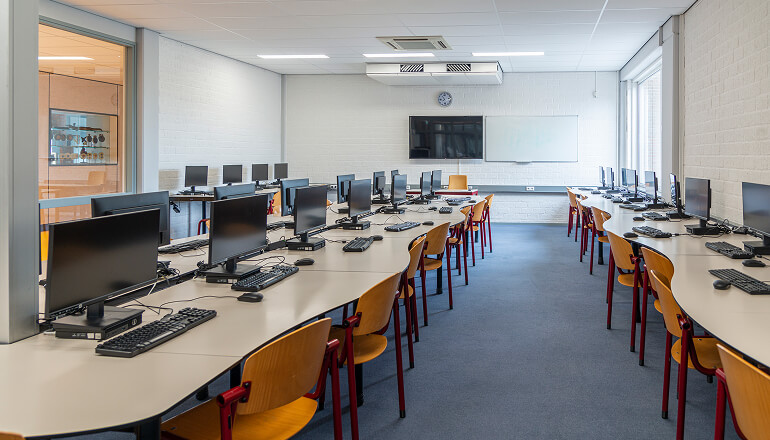Article Examples of Technology in the Classroom
In recent decades, technology has fueled a dramatic shift in everything from business and communications to government, the economy and more. Since merging with the traditional classroom, the digital world has also opened new avenues for teachers to personalize learning for diverse student populations, enabling more students to reach their full potential. Let's explore some examples of modern technology in the classroom.
By Debbie Malone / 16 Nov 2016 / Topics: Hardware

Yet, K–12 education is the one area in which the digital transformation still lags behind.
According to the Office of Educational Technology’s National Education Technology Plan, “Preparing students to be successful for the future requires a robust and flexible learning infrastructure capable of supporting new types of engagement and providing ubiquitous access to the technology tools that allow students to create, design and explore.” The plan lists powerful learning devices as essential components to achieving this. Fortunately, IT providers are stepping up to the plate to make it easier and more cost-effective for schools to implement learning technology in the classroom.
Making technology accessible to schools
At Dell EMC World 2016, Anthony Salcito, Microsoft’s vice president of worldwide education, spoke about the desire of education stakeholders to equip students with tools to drive their future success. “The aspiration of every parent, of every student, every government leader for change in their classrooms is the same … maximizing the potential of the students to drive not only change in their community and their society to grow industry but really fulfill the potential that we have as humans inside of classrooms. That’s what parents want of their children. We see that consistent globally,” says Salcito.
That’s why tech giants like Dell and Microsoft have led the industry by expanding the number of IT solutions and services available to meet the needs of schools and districts. And with more devices and equipment options to choose from across a broader range of price points, schools can overcome budget constraints and build IT infrastructures that meet their goals. However, the examples set by teachers who use that technology in new and innovative ways can’t always be replicated.
“Change is hard to scale … That’s partly because, in education, the change that we see has been very much built around the individuals driving that on their own perseverance, their hard work and effort, and we’ve got to bring much more scale with leadership, with vision and making these tools easier to use to change learning environments,” Salcito adds. Teachers have a lot on their plates, so for classroom technology to truly make a difference on the grander stage, it needs to be easy to use — and not just for an enlightened few.
Future-ready solutions that work for teachers
IT providers aren’t solely focused on the variety of devices they can offer to schools. Future-ready classroom technology must also solve the challenges teachers face in the classroom every day without becoming yet another hurdle. That means ease of use has a big role to play. Teachers need technology that can blend seamlessly into their day-to-day rhythms. In fact, a study published in Computers in Human Behavior showed that more complex technologies are more likely to be abandoned.
Recently, Dell launched the future-ready Dell classroom blueprint, an interactive tool designed to give education IT decision makers a look at the latest in future-ready learning from Dell and Microsoft. The tool also helps users understand how each device can fit into daily routines and activities. Users can scroll over various devices within the blueprint and click on them to see an explanation of how each one can be used in the classroom. While exploring the future-ready blueprint, users can even create their own custom blueprint by selecting the products they’d like to learn more about.
Some of the devices you can add to your blueprint include 2-in-1 tablets, monitors, interactive projectors and mobile computing carts.

2-in-1 tablets
The Dell Latitude 2-in-1 tablet features a removable keyboard so it can be used by students as either a laptop or a tablet. Devices like these make it easier for teachers to move lessons outside of the classroom or into a lab. Meanwhile, students can still jot down notes using a stylus. The Latitude tablet is also built with premium materials, so it’s durable enough to take a hit, which — let’s face it — is inevitable with students.

Interactive monitors
Dell offers a range of monitors, including LCD, LED backlit and ultra HD displays, but the Dell 70 Interactive Conference Room Monitor is built for future-ready classrooms. Teachers can display lessons on the monitor and use a stylus to write directly on the screen. With the touch of a finger, teachers and students can also interact with objects, maps or images on the display.

Interactive projectors
Touchscreen monitors aren’t the only way to engage students in visual, interactive lessons. The Dell Interactive Projector-S520 can also work in conjunction with a stylus, through touch or by using traditional dry-erase pens. These future-ready projectors combine some of the best features of interactive whiteboards and LCD displays, enabling teachers and students to work together on multimedia lessons or collaborate on creative projects.

Mobile computing carts
Mobile computing carts are essential for schools with shared device programs. It’s the best way to keep devices securely stored and organized for fast distribution and collection, saving educators precious minutes of class time. Dell mobile computing carts also make it easy to transport devices from one location to another while keeping them charged and ready to use.
Benefits of technology in the classroom
The effect of putting world-class technology in the hands of students and teachers goes well beyond the interactions that take place at school. “Teachers can leverage the fact that students can leverage their learning environment beyond the classroom time. They can connect with each other. They can have a one-on-one dialogue with an educator. They can learn from a variety of perspectives of genders, of religions, of races, beyond the capabilities of an individual educator,” says Salcito.
He adds, “The educator that can embrace that and inspire students to pursue that learning journey with passion and purpose — they can take their potential further than they could in the traditional classroom environment.”






